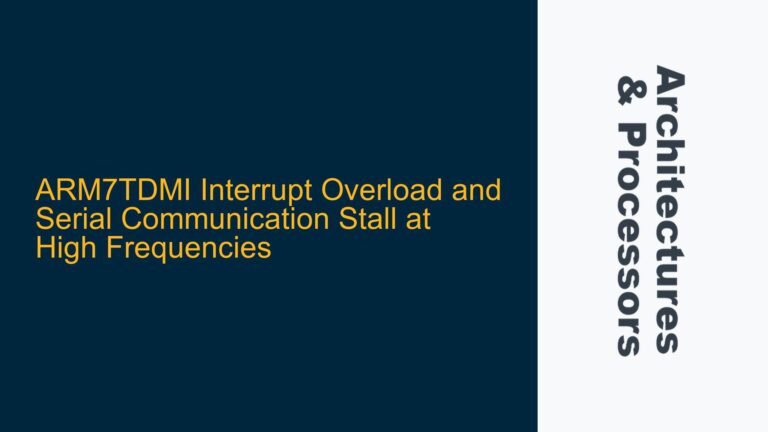ARM Cortex-M0 32-bit Multiplication and Shift Operations
The ARM Cortex-M0 is a highly efficient, low-power processor designed for embedded applications. However, its limited instruction set and lack of hardware support for certain operations, such as 64-bit multiplication, can pose challenges for developers working on digital signal processing (DSP) tasks. One such challenge is efficiently computing the top 32 bits of a 32-bit x 32-bit multiplication, a common operation in DSP algorithms like MP3 decoding. The Cortex-M0 does not natively support 64-bit multiplication results, requiring developers to implement custom routines to achieve this functionality.
The core issue revolves around the need to perform a 32-bit multiplication and extract the upper 32 bits of the 64-bit result. The Cortex-M0’s instruction set includes 32-bit multiplication instructions, but these only return the lower 32 bits of the result. To obtain the upper 32 bits, developers must implement a multi-step process involving shifts, additions, and carry management. This process is further complicated by the Cortex-M0’s limited register set and the absence of certain instructions, such as rotate with carry (RRX), which would simplify the extraction of the upper bits.
The current implementation of the MULSHIFT32 routine involves breaking down the 32-bit operands into 16-bit halves, performing partial multiplications, and then combining the results while managing the carry bit. This approach, while functional, is not optimal in terms of cycle count, particularly for applications where the routine is executed millions of times per second, such as in real-time audio processing.
Carry Bit Management and Instruction Set Limitations
One of the primary bottlenecks in the MULSHIFT32 routine is the management of the carry bit (C) during the addition of partial products. The Cortex-M0’s instruction set lacks direct support for moving the carry bit into a specific bit position within a register, requiring multiple instructions to achieve this. For example, the current implementation uses a sequence of movs, adcs, and lsls instructions to move the carry bit into bit 16 of a register. This sequence consumes four cycles, which is inefficient given the tight timing constraints of DSP applications.
Another limitation is the absence of an immediate operand version of the rotate right (ROR) instruction in the Cortex-M0’s Thumb instruction set. The ROR instruction is crucial for efficiently shifting the carry bit into the correct position within the result register. However, the Cortex-M0 only supports ROR with a register operand, which adds additional overhead to the routine. This limitation forces developers to use alternative instructions, such as logical shifts and additions, to achieve the desired result, further increasing the cycle count.
The lack of a rotate with carry (RRX) instruction on the Cortex-M0 exacerbates the problem. The RRX instruction, available in more advanced ARM architectures, allows the carry bit to be directly incorporated into the result of a rotate operation, simplifying the extraction of the upper bits of a multiplication result. Without this instruction, developers must resort to more complex and less efficient workarounds, such as using multiple shifts and additions to manage the carry bit.
Optimizing the MULSHIFT32 Routine for Cortex-M0
To optimize the MULSHIFT32 routine for the Cortex-M0, developers must focus on reducing the cycle count by minimizing the number of instructions required to manage the carry bit and combine the partial products. One potential optimization involves reordering the instructions to reduce dependencies and allow for better instruction pipelining. For example, the current implementation performs the carry bit management after the partial products have been added, which introduces a dependency chain that limits parallelism. By reordering the instructions, it may be possible to overlap the carry bit management with other operations, reducing the overall cycle count.
Another optimization strategy is to leverage the Cortex-M0’s limited register set more effectively. The current implementation uses multiple registers to store intermediate results, which can lead to register pressure and additional move instructions. By carefully selecting which registers are used for which operations, developers can minimize the number of move instructions and reduce the overall cycle count. Additionally, using the stack pointer (SP) as a temporary register during NMI (Non-Maskable Interrupt) routines can provide an extra high register, further reducing register pressure.
A more advanced optimization involves unrolling the loop of the MULSHIFT32 routine. While this approach increases code size, it can significantly reduce the cycle count by eliminating loop overhead and allowing for more efficient instruction scheduling. However, this trade-off between code size and performance must be carefully considered, particularly in memory-constrained embedded systems.
Finally, developers should explore the use of compiler intrinsics and assembly language to achieve the lowest possible cycle count. While the Cortex-M0’s C compiler can generate efficient code, hand-optimized assembly language can often achieve better performance by taking advantage of specific instruction sequences and pipeline characteristics. For example, using the rors instruction with a register operand, despite its limitations, can still provide a performance improvement over the current implementation.
In conclusion, optimizing the MULSHIFT32 routine for the ARM Cortex-M0 requires a deep understanding of the processor’s instruction set and pipeline characteristics. By carefully managing the carry bit, reordering instructions, leveraging the register set, and considering loop unrolling, developers can achieve significant performance improvements for DSP applications. While the Cortex-M0’s limitations present challenges, careful optimization can enable efficient execution of complex algorithms, even on this low-power processor.






